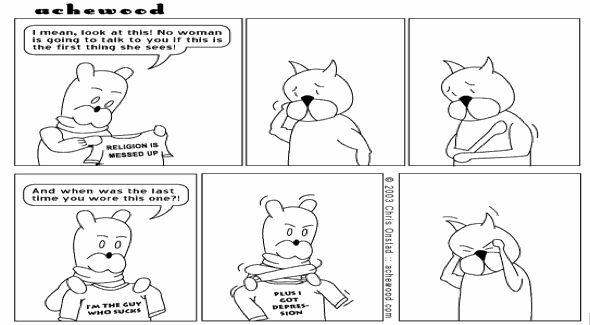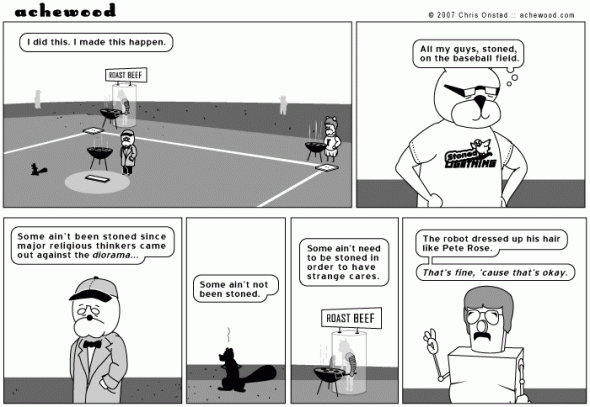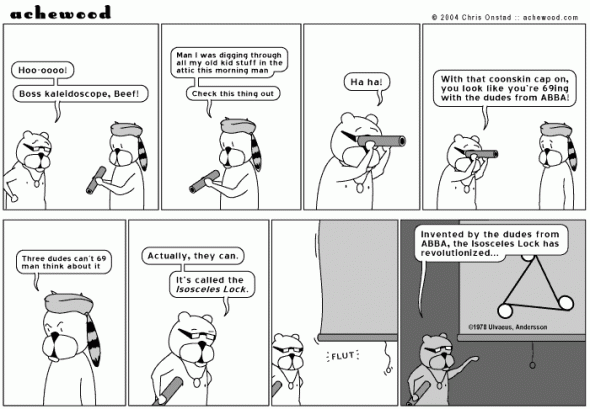In his trainwreck of an interview in the A.V. Club, the first words Dave Sim uses to describe his graphic work, Cerebus, are “the longest sustained narrative in human history.” While that’s indicative of Sim’s pompous attitude, it also speaks to the size of his accomplishment. Of all the things you’d expect to tell a coherent story over thirty years, a serial comic about a barbarian aardvark is not one of them. The feat seems more impressive because of the mundanity of its protagonist. That the comic book medium could tell such a story is impressive; that an aardvark could tell such a story is almost inconceivable.
I feel the same way looking back on Chris Onstad’s Achewood, the beloved webcomic that kicked off ten years ago this month and came to a sputtering end earlier this year. Telling an interesting story is hard enough to do that one would think it’s enough. Telling an interesting story that’s also full of belly laughs is noteworthy. Telling an interesting story full of belly laughs in an irregular webcomic is an Olympian feat. But telling an interesting story, laughs, webcomic, etc, with talking cats and stuffed animals in the Southern California suburbs as protagonists is absurd. It’s incomprehensible that someone could succeed so well with such material. Picture Roger Bannister breaking the four-minute mile barrier in 1954 by running a mile in 71 seconds, while drunk. Or Dock Ellis pitching a no-hitter on LSD, which has the added virtue of having actually happened and would doubtless appeal to Onstad, the genius behind Stoned Lightning.
Picking apart Onstad’s masterwork is a daunting task. Achewood itself is hard to grapple with, due in part to its absurd voice, the webcomic genre (relatively scant of critical texts so far) and the shift in focus over its run. So this analysis will be broad by necessity. Bear with me, as I hope it’s worth the ride.
ACHEWOOD AS SHE IS SPOKE
With a story that spans ten years, a cast of dozens of characters and hundreds of strips, where does a newcomer start with Achewood? Opinions vary. Completists may want to start from the very beginning, but be warned that the first six months of strips have only a modest relation to what came later. “The Party” is the first story arc in the drop-down menu available on the front page, but that skips some details that newcomers might find interesting – Teodor’s relationship with the mythical Penny, the introduction of Ray, etc. I can’t stand people who praise a series but insist I have to invest 40 hours into it to “really get it,” but there’s a lot of ground to cover with Achewood.
But at the same time, Achewood might not be your thing. I remember being one of the few people in my circle of friends – maybe the only one – who liked Bill Griffith’s Zippy the Pinhead. Zippy’s non sequitur juxtapositions of consumer culture and obscure literary references tickled my absurdist funny bone. Achewood speaks in a similar voice, blending street culture, middle American suburbia, historical trivia and talking cats in a wild, challenging ride.
My recommendation has always been to start at May 2004 in the archives and read the entire month. It’s 20 strips, so you can bang through it in less than half an hour. That month, for whatever cosmic reason, is a good blend of approachable gags, bleak humor and context-free absurdity. It’s a good microcosm of the comic as a whole. If after 20 entries you don’t find yourself curious for more, you can abandon the series without guilt.
Plus, if nothing else, starting there will introduce isosceles lock into your vocabulary.
If you’ve never read Achewood, nip off to May 2004 and give Onstad a try. If you have, it’s worth a return visit to refresh yourself on his style. I’ll wait for you here.



Fitting sendoff for a great series (and cookbook!)
Just so you know, most of the in-line links are broken, looping only back to the overthinkingit site.
I’m also really happy to see something referring to 9/11 without being either a blindly patriotic appeal or simple mocking joke. It’s nice thing to see.
Dog damn it. Effing Google Docs (where I draft most of these) insists on putting the wrong side curly quotes whenever I type up an A HREF. Fixing now; thanks for the heads-up.
Anyone who knows how to turn off curly quotes in Google Docs settings, please let me know. I will reward you with spices from Araby, silks from Cathay.
Figured it out. Spices and silks will be left on the curb.
First sentence, link is broken.
I remember the AIBO and the Galaxie 500. If only the AIBO could have moved like the 500.
Fixed, thanks. Everyone should skim that interview, if only as an artifact of modern journalism. Consider that’s the version of the interview that was edited to read as civilly as possible and consider what the actual conversation must have sounded like. And there’s still good stuff there!
This is a far better, more thorough argument for reading Achewood than I’ve been able to come up with on my own. One of my favorite pieces of fiction in any form, and I can hardly get anyone to read it. I’ll be sending this link out all over the place!
Thank you! I struggled to articulate the merits of the strip for a while. I hope it pays off.
minor nitpick — I think it’s set in Northern California. The layout of Achewood is based on Palo Alto.
also, for those people who haven’t read Achewood before, be sure to read the alt-text on the cartoons after 2003 or so (just hover the mouse over the cartoon).
there’s a restaurant on the SF Peninsula that Chris did a lot of his drawing at, and some of the artwork on the walls is posters from old Great Outdoor Fights.
Noted. See update on pg2.
I grew up in the South Bay, went to college in the Inland Empire (Harvey Mudd!), and am now in graduate school in Ohio. I can honestly say there’s not that much difference between the wealthy suburbs in Palo Alto and the wealthy suburbs of the Inland Empire, and by extension the suburbs of the Midwest. Maybe the area around Palo Alto is a little less conservative and a little more yuppie, but I think suburbs everywhere in the United States are pretty homogenous.
I hope most of the world is not thinking of San Francisco when they think of SoCal, because San Francisco is in NorCal (where I’m from). Not that there’s really a whole lot of difference between the two, in the grand scheme of things.